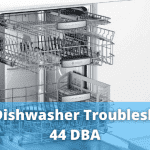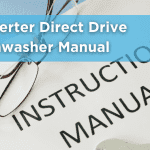Table of Contents
If you’re facing the issue that your dishes aren’t getting clean, it might be time to investigate.
An ineffective dishwasher could be several reasons, such as a dirty filter, blocked spray arm, or broken soap dispenser. We’ll go over the possibilities and how to repair them below.
You can get back to having clean dishes in no time if you follow these steps! It’s simple once you know what to do. Continue reading for more information on how to solve this problem!
Troubleshooting Tips
When your dishwasher is not getting dishes clean, try cleaning the machine. If that doesn’t work, then you should do regular maintenance. Sometimes the problem is not the machine but instead the dirty parts inside of it.
Here are some of the most common reasons why your dishwasher may not be cleaning:
Dishwasher Dirty Interior
The inside of your dishwasher can get dirty. You might find grease, food bits, soap scum, and more. Get these out by cleaning the inside of your dishwasher. If it is not too bad, run a cycle with 3 cups of white vinegar to get rid of the grease and other things left behind. To get rid of difficult or stubborn grime, you can use these dishwasher cleaning tips!
Dishwasher Gunky Filter
If your dishwasher’s filter is full of gunky food particles, it needs to be cleaned. Remove it from the machine and rinse thoroughly with hot water for several minutes to clean the filter. Depending on how stuck-on the gunk is, you can soak in soapy water or gently scrub using a soft brush before rinsing again under running hot water.
Older dishwashers (those manufactured before 2010) almost certainly have a self-cleaning filter that works by grinding down food particles until they are small enough to wash away. Newer, muted versions typically feature a detachable filter that must be replaced and cleaned regularly.
Spray Arm
Cleaning your dishwasher spray arm can help improve the output of water pressure. There are two ways to clean it, depending on what type you have: snap off for cleaning or remove a screw and take it out. Use soap with hot water after scrubbing gently with a soft brush to flush away clogs in holes and then rinse well before snapping back into place or putting back in.
Broken Soap Dispenser
The detergent may not reach your dishes or be released at the proper time during the wash cycle if your soap dispenser isn’t working correctly. A common issue with soap dispensers is a jammed spring in the door. Start by cleaning any dust or debris that may be preventing it from opening, then mix hot water and vinegar to dissolve grease. If these remedies don’t work, try replacing components of your soap dispenser like springs and gaskets periodically for optimum performance.”
Finally, examine the gasket around the dispenser and replace it if it is damaged. A little dab of petroleum jelly on the gasket once in a while may help to keep it longer. Check out our latest post is it possible to use regular dish soap
Low Water Temperature
The dishwasher cycle requires a water temperature of at least 120 degrees Fahrenheit to work correctly. Some models have an additional heat-boosting mechanism, but if yours doesn’t, ensure that your water heater is set the right way before starting it up. Finally, you can run the kitchen faucet for 30 to 60 seconds just in case there’s not enough hot water entering into a machine when started, ensuring everything goes smoothly during use!
Detergent and Related Issues
Improper use of dishwasher detergent can lead to spotty dishes. Using too much or low-quality ingredients will cause problems, so be sure you’re using the right type and amount for your recipes.
If hard water is a problem in your area, consider installing an appliance that softens it like most modern washing machines do; this ensures minerals don’t end up on our plates! Lastly, load the machine correctly by following instructions when possible—otherwise, rinsing after each cycle may help remove any heavy deposition left behind.
Water Volume or Pressure Issues
If you notice that your water pressure has been lower than expected, it’s time to call Mr. Rooter Plumbing for a diagnostic inspection – just like the professionals at Mr. Appliance! Both are trusted Neighborly brands with years of experience in fixing all kinds of household appliances and plumbing problems.
Failing Inlet Valve
If you’ve recently noticed a hammering sound coming from the unit as it runs, your dishwasher is likely experiencing an issue with its inlet valve. This part of the machine allows water to flow into the dishwasher and can be difficult for homeowners to replace on their own. For more information or troubleshooting steps, reference the owner’s manual!
Summary
We hope this blog post has helped you understand the possible problem with your dishwasher and potential fixes. If it hasn’t, or if you have any questions about how to fix these problems in general, please email us at ubaidanwarhussain@gmail.com. Our team of experts is happy to help!





[…] the right dishwasher detergent tabs can be a complex process. There are so many different brands out there, and it’s hard to […]
[…] Is Your Dishwasher Not Cleaning Well? Here Is The Solution! […]